This episode we talk exoskeletons: what are they being used for now? What might they be used for in the future? And what happens when they’re everywhere?
Guests
- Tim Pote, PhD student at Virginia Tech
- Greg Pote, Tim’s brother
- Dr. Bill Marras, professor at The Ohio State University & Director of the Spine Research Institute
- Larry Jasinksi, CEO, Rewalk
- Ashley Shew, assistant professor at Virginia Tech in technology & disability, and author of Animal Constructions and Technological Knoweldge
- Kim Sauder, graduate student in Disability Studies, author of Crippled Scholar blog
- Bill Peace, anthropologist & bioethicist, author of Bad Cripple blog
Further Reading
- The robotic exoskeleton market is poised to grow to $1.9 billion in 2025, compared to $97 million in 2016, says ABI Research’s Dan Kara.
- Berkeley BLEEX Exoskeleton
- Exoskeletons Won’t Turn Assembly Workers into Iron Man
- We Try a New Exoskeleton for Construction Workers
- The Exoskeletons Are Coming
- ReWalk Testimonials
- Cyberdyne’s Medical Exoskeleton Strides to FDA Approval
- This $40,000 Robotic Exoskeleton Lets the Paralyzed Walk
- For heavy lifting, use exoskeletons with caution
- Biomechanical evaluation of exoskeleton use on loading of the lumbar spine
- Exoskeletons for industrial application and their potential effects on physical work load
- The effects of a passive exoskeleton on muscle activity, discomfort and endurance time in forward bending work.
- The Exoskeleton’s Hidden Burden
- Walking is Over Rated
- The Obsession With Walking
- Exoskeletons as a Social Problem
- You Cannot Kill a Bad Idea: The Exoskeleton Lives
- ReWalk: A Plea for Common Sense
Flash Forward is produced by me, Rose Eveleth. The intro music is by Asura and the outtro music is by Hussalonia. The future historian this episode was played by Sarah Warner. The episode art is, as always, by Matt Lubchansky.
If you want to suggest a future we should take on, send us a note on Twitter, Facebook or by email at info@flashforwardpod.com. We love hearing your ideas! And if you think you’ve spotted one of the little references I’ve hidden in the episode, email us there too. If you’re right, I’ll send you something cool.
And if you want to support the show, there are a few ways you can do that too! Head to www.flashforwardpod.com/support for more about how to give. But if that’s not in the cards for you, you can head to iTunes and leave us a nice review or just tell your friends about us. Those things really do help.
That’s all for this future, come back next time and we’ll travel to a new one.
FULL TRANSCRIPT BELOW
▹▹ ▹▹ ▹▹ ▹▹ ▹▹ ▹▹ ▹▹ ▹▹ ▹▹ ▹▹ ▹▹ ▹▹ ▹▹ ▹▹ ▹▹ ▹▹ ▹▹ ▹▹ ▹▹ ▹▹ ▹▹ ▹▹ ▹▹
Hello and welcome to Flash Forward! I’m Rose and I’m your host. Flash Forward is a show about the future. Every episode we take on a specific possible… or not so possible future scenario. We always start with a little field trip to the future, to check out what’s going on, and then we teleport back to today to talk to experts about how that world we just heard might really go down. Got it? Great!
This episode we’re starting in the year 2085.
[Shuffling papers]
[Microphone noise]
Hi, so, um, thank so much to the art history department here for having me.
So, looking out at the audience today, I’m going to guess that most of you have never actually seen one of these in the wild.
[stifled laughter]
I know, it’s probably hard to imagine that people used to wear these right? So, how many of you are wearing something powered today, a show of hands. Yeah, and of course, I’d never know. So today I want to talk to you about how the rise in powered clothing changed the dance industry. But let’s start with a little bit of history.
So, we could start our story a lot earlier than this, but for simplicity’s sake let’s begin on January 28th, 1890. That is the date on which a Russian inventor named Nicholas Yagn got the patent for a powered exoskeleton. He didn’t call it that though, his patent was called “an apparatus for facilitating walking” and, you can see that here.
[laughter again]
I know, isn’t that beard amazing? But so, Yagn designed this thing for soldiers in the Russian Army. The idea was that it would make them run faster. But, there is no documented evidence that Yagn’s device was ever actually built or operated. So, the jury’s out on whether this actually works or not. There are a whole bunch of delightful patents, though.
So, let’s fast forward a while, up to the 1960’s. In 1965, with funding from the U.S. military, General Electric started developing something called the Hardiman; the name was a mashup of “Human Augmentation Research and Development Investigation” and “MANipulator.”
Here’s the Hardiman. It was huge and totally impossible to use. The entire device weighed 1,500 pounds. So in the 1970’s GE abandons that project.
And it’s really not until the early 2000’s when we start to see a big acceleration in this technology, largely funded by the American Military. So when powered clothing started to really come out onto the market commercially in the mid 2020’s, the first way that dancers and artists engaged with it was as a response to that military origin. So here’s a still from the very famous dance choreographed by Johnny Rico called BLEEX. I’m sure some of you are familiar with it.
You also had Ellen Louise’s performance piece called Caterpillar where she would power on and off, and give commands to empty suits laying on the ground.
But I want to focus the majority of this talk on the way that traditional ballets have incorporated these suits into their repertoire. Because I think it really exemplifies the way that a very traditional ballet system is in fact influenced by outside factors and the modern world more than perhaps they like to admit. So we’ll go through some examples of the ways that classical ballet has used these powered skeletons in dialogue with both technology and by its modern and interpretive counterparts.
So let’s begin by watching a clip of this dance, this is Coppelia performed by the New York City Ballet.
[[Music up]] [[Fade out.]]
Rose: So today’s episode is all about exoskeletons.
Of course, there are plenty of science fiction versions of the exoskeleton right? Ripley uses a sweet exoskeleton in Alien, in the sci-fi classic Starship Troopers the soldiers wear exoskeletons. Lots of superhero type characters have them like Ironman and Samus. In Halo everybody wears a super suit type thing. The idea of some kind of suit you can put on to get super strength is ubiquitous in all kinds of science fiction and fantasy. And it’s been a dream of the military for a long time.
And in fact, the history you heard up at the top of the show is real. The first exoskeleton patent is indeed from 1890 and was designed for the Russian military. And that’s the realm that exoskeletons have mostly lived in until relatively recently. They were military products, designed and developed by groups like DARPA. In the 2000’s, DARPA funded a projected called the Berkeley Lower-Extremity Skeleton, also known as BLEEX. In the nearly twenty years since then, the exoskeleton market has boomed and sub-divided. Some companies focus on making exoskeletons for laborers, people who have to do a lot of repeated heavy lifting. Other companies have focused on exoskeletons for disabled people, trying to restore their ability to walk upright. And we’re going to consider those two types of exoskeletons separately on this episode, because while the root technology is really similar between the two, the impact and ramifications and cultural questions surrounding them are really different.
So let’s start with exoskeletons designed for manual labor.
Bill Marras: exoskeletons are trying to solve a problem that has been an issue and work environments for ages.
Rose: This is Bill Marras, a professor at Ohio State University and the director of the Spine Research Institute. One of the things Bill studies is how manual labor can impact the body.
Bill Marras: You know everybody gets aches and pains everybody gets you know back problems and shoulder problems. You know just naturally here and there. But the real severe ones are really exacerbated by the work and it’s exacerbated by, you know, exposure for you know 40 plus hours a week typically, um, you know just doing things that your body has not cut out to do every day.
Rose: The idea that working on a construction site or a manufacturing warehouse or any number of other jobs might come with health risks probably isn’t surprising to you. Factories and workplaces have had to deal with the toll that this kind of work can take on bodies for a long time. And people have invented all kinds of things that can make this work easier: cranes, lifts, pullies, that kind of thing. But those can only help so much because they have to be maneuvered into place, and they’re generally pretty big and unwieldy and require special training to use.
Bill Marras: So you might be over in one location for, you know doing a job for two minutes, and then move somewhere else for five minutes, and somewhere else for three minutes, you’d have to you know you’re going to incorporate into an intervention such as lift or a hoists you’d have to move all over the place which wouldn’t be practical.
Rose: So here’s where the exoskeleton comes in.
Bill Marras: We’ll just make the person superhuman we’ll just put the intervention on the person let the person control it and then wherever they are they could do whatever kind of material handling they need to do without having to move the device, it moves along with you.
Tim Pote: Yes so the primary exoskeleton that we’re working on right now is a core body assistive lifting device. Soit’s meant more for an able bodied individual that is doing repeated lifting. You know say 40 to 60 pounds several hundred times a day.
I’m Tim Pote, I’m a graduate researcher at Virginia Tech working on exoskeletons and wearable robotics.
Rose: So there are two main types of exoskeletons for the workplace: passive and active exoskeletons. Tim works passive exoskeletons, which means that there aren’t motors helping you lift whatever it is you’re lifting in the suit.
Tim: If you can imagine like camping, or like a hiking backpack shoulder straps and hiking backpack waist belt, and then similar looking leg pads that kind of come around from the back and attach over the top of your thigh. Those are the three primary contact points with the body. The structure of the exoskeleton actually carbon fiber and there’s carbon fiber rods that run from down along lower leg to your mid-back and then additional rods that run from your mid-back all the way up to your shoulders.
Rose: So these rods are what the suit relies on to function. As the wearer bends down to lifts things, the rods help make the standing back up part, easier.
Tim: There’s carbon fiber rods are actually acting very similar to a bow and arrow. And when you pull it back if you can picture the shape of the bow, so that’s loading up and it’s storing the energy in that carbon fiber and then when you stand back up the rod straighten back out and they return that energy.
Rose: There are all kinds of passive exoskeletons on the market right now. Last year, Ford Motor Company tested out a passive exoskeleton called the EksoVest. According to Ford, employees in their assembly lines lift their arms up over their heads 4,600 times per day. The EksoVest is designed to help them do that repeated motion with less strain on their arms and back. But you don’t have to go to a state of the art assembly line to see workers in exoskeletons. In fact, you might have actually seen an exoskeleton in use the last time you watched a football game.
Bill Marras: You’ll see a lot of these used to hold cameras, to hold the television cameras and you’ll see you know after a play you’ll see a guy, you know the cameraman running around and he’s got this big contraption around his shoulders and his waist and his chest and the cameras just hanging there. That’s a very basic type of exoskeleton.
Rose: The other type of exoskeletons are active ones, ones that actually have motors that help people move their bodies. While passive exoskeletons have been on the market for a while, these active exoskeletons are still mainly in the testing phase. And that’s in part because as soon as you add motors to something that someone is wearing, they can get really dangerous.
Bill Marras: I’ve been in some meetings with some companies and one of the things are definitely afraid of is you know everybody’s going to think they’re Sigourney Weaver from Alien, you know, wearing one of these things, and they’ll have superhuman strength, and they’ll be, you know, trying to fight each other and you know horse around and these things are very very powerful you know. There’s just there’s a potential to really hurt people if misused these.
Rose: So, for both kinds of exoskeletons, passive and active, the premise here is that an exoskeleton can help people lift more things, more safely, by helping take stress off their joints and muscles. But it turns out there are very few studies that actually try and test how well these suits actually do that. And by that I don’t mean whether they can make someone lift things, that part is pretty clear cut. It’s the safety element that’s been really under-studied. There are very few papers out there that try to quantify the risks to someone’s body when they are using these exoskeletons. The papers that do exist only look at the specific joints that the exoskeleton is meant to assist, not anything else. But practically, that leaves out a huge amount of information.
Bill Marras: We typically have to look at the whole body as a system you know what is a tradeoff with one one part of the body or another.
Rose: So let’s say that you have something heavy on the floor, and you want to lift it. And you’ve heard that lifting is much safer if you keep your back totally straight. Which is probably technically true, but if you try to actually do that, it means you have to bend your knees really deeply.
Bill Marras: So it may be better for the back but much worse for the knees and hips and so you know you can think of all kinds of examples where there’s tradeoffs with the knees and the hips and the shoulders and the elbows and all over the body you really have to look at the system of the body.
Rose: So if the exoskeleton is meant to help the shoulders and elbows, most studies look at only the shoulders and elbows. What they might miss is that while there’s less pressure on the users shoulders and elbows, all that pressure might have actually just been transferred to their back or their hips or their knees. So you’re not alleviating the pressure, you’re just shifting it elsewhere.
So Bill noticed this gap in the research, and decided to do some of his own studies. His team recently published a paper on one of these passive exoskeletons.
Bill Marras: The ones we’re looking at are ones that are just around the torso. So they go up around the shoulders or on the waist and then they had a little spring arm support in front of them that will hold the tool that you’re using.
Rose: These are the same exoskeletons we mentioned earlier that you might have seen at sporting events. They’re also used in factories when workers are lifting heavy tools over and over again. So Bill had participants come into the lab, and use two tools: a heavy tool and a light tool. And he had them use those two tools with and without the exoskeleton. While they used the tools, Bill’s team took measurements on the stresses that this person’s body was experiencing, particularly focusing on the participant’s lower back.
Bill Marras: We focus on the low back is because that’s where the vast majority of musculoskeletal disorders are, it’s the number one reason people miss work, is bad disorders.
Rose: And with all that data they compared the stress on the lower back with and without the exoskeleton.
Bill: We were pretty surprised. Most of the time when you look at interventions, we’re kind of used to seeing tradeoffs you know it’s better in one situation but worse than another that’s kind of what we expected to find. But when we compared these conditions almost every condition the exoskeleton was worse than not wearing the exoskeleton, which kind of shocked me.
Rose: Basically, the exoskeleton might help alleviate some of the pressure on someone’s shoulders or elbows, but it makes the pressure on their lower back way worse.
And Tim says that this is one of the biggest challenges of designing an exoskeleton, making it work with the body. It’s easy to design a machine that can lift a lot of weight. But this isn’t just a machine that can lift a lot of weight, it has to be a machine that can work with a human body to lift a lot of weight.
Tim: So you’re going to laugh, but the biggest problem is always the person. The mechanics surrounding it are, you know, the engineering side is really well understood. Where you start getting into the difficulty is trying to make a device that will fit a wide range of you know human body shapes and sizes, because it doesn’t really do you any good if you make one suit that fits the 50 percentile male. You know it just it’s too confining and so we need to make something that’s not only going to be adjustable but you know in terms of the size and the fit but also comfortable for people of varying sizes body shapes.
Rose: And Bill’s studies have shown that so far, nobody has really cracked this problem.
Bill Marras: It really doesn’t fit anybody. And the way we describe this it’s is it’s kind of like dancing with a really bad partner. So you’re moving one way and you know the exoskeleton wants to move in a different way and at certain ranges of motion may be lined up well and it moves very easily in other ones i’s offset and so it’s going to move and it can give you all kinds of resistance.
Rose: Ultimately, Bill thinks exoskeletons could certainly still be useful, but when he works with companies who might want to introduce them he advises them to proceed with caution.
Bill Marras: Let’s be very very careful here, and let’s look at the types of jobs are you think these might be useful and look at you know you know what that cost benefit it is for every task you’re looking at because working overhead is different from working at waist level. And it all depend on you know the weight of the tool you’re using and there’s a lot of moving parts. You know, not to use a pun, but there’s a lot of different things to think about when you’re looking at that system. And so you know what I’d caution them about is it’s not a silver bullet. A lot of people think okay I can get rid of all these problems, I’ll just put an exoskeleton on the person and I won’t have to worry about the design of the workplace but, that’s not the way it works.
Rose: So far, Bill’s team hasn’t managed to test any of the active exoskeletons that are starting to hit the market.
Bill Marras: That may change everything we don’t know. We haven’t tested them yet and we are going to be testing those in a few months here.
Rose: And beyond risks to individual humans whether they’re using the exoskeletons properly or not, I think there’s also something to be said for pausing, and considering what these exoskeletons say about the future of work more broadly. As humans are replaced by machines in the workplace, these exoskeletons allow our measly fleshy bodies to keep up, at least for a little while. But they also make very literal the idea of a worker being a machine. Someone whose use is measured by a ratio of valuable work to potential workers comp payouts.
Bill Marras: OK so now your one person could do the job of five people. Is that realistic? Or are we just finding other ways to hurt people and these exoskeletons by wearing them out in different kind of ways.
Rose: There is something slightly dystopian in the way we’re hurtling towards this future where we’re totally cool with turning humans into machines so that they can produce MORE and work MORE and take LESS breaks.
But we can also spread this future out a further than the factory floor. Because the logical next generation of these bulkier, more industrial exoskeletons, is something called “powered clothing.” These are clothes that are designed and engineered to give people support and help. There are companies like Superflux, who are designing these kinds of suits for older people to wear, to help stabilize them and give them help walking around. And the Superflux designs aren’t big hulking exoskeletons, they’re garments. Clothing, that soon you could wear underneath the rest of your clothes.
And this I think is one of the big pieces of the future of exoskeletons. Not for manual labor or farming or assembly lines. But for ordinary people who want a little more strength and endurance and stability throughout the day. Imagine wearing one of these things for a whole day of wandering museums, or working on your feet in any industry, or caring for your kids. Imagine every time you had to pick up your toddler you got a little bit of help from your clothes. That’s a real possible future that lots of companies are talking about, and betting on.
But there’s a whole other world of exoskeletons out there that have nothing to do with factory floors or assembly lines. These are exoskeletons designed for people with various forms of paralysis, usually due to spinal cord injury. Now, these two groups aren’t really THAT separate, I want to be clear. In fact, often you’ll see technologists pitching their work as being for disabled people, when in fact what they want to do is build exoskeletons for, say, the military or manufacturing. But they can get money for the more medical side.
And we’re going to talk about exoskeletons for the disability market, and why some disabled people aren’t exactly fans. But first, a quick word from our sponsors.
[[AD BREAK]]
Rose: Okay so we’ve covered the world of exoskeleton in the manual labor intensive workplace. But chances are you’ve seen another exoskeleton in the news. And those are the ones designed to help paralyzed people walk again.
Larry Jacinski: We have six joints to move, and we move the ankle joints with a spring device that lifts that foot as you’re making each step so you don’t strike your toes. We have a knee device, which will move the foot forward for each step. And then we have one at the hip that actuates the hip for each stride as you’re coming back.
Hi I’m Larry Jacsinski, I’m the CEO of ReWalk reobotics.
Rose: ReWalk, one of the most well known companies in the world of medical exoskeletons. And ReWalk actually makes two different versions of its exoskeleton. One is for use in the hospital, to help train all kinds of patients who might need help re-learning how to walk. This could include people who have strokes, or certain kinds of spinal cord injuries, where they have to retrain their brains and bodies to walk again.
The other ReWalk device, the one you’ve probably seen in the news, is for patients who won’t regain the ability to walk on their own. The exoskeleton moves their lower body for them.
Larry: So when a person wants to go somewhere, they’re wearing a little wrist controller and on the wrist controller they will push a button and a light will light up and it’ll be: standing, going up a stair, or going down a stair, walking. They’ll set it to the right setting. Nothing will happen until they elect to move their body. So if they move forward three millimeters the device will then begin to walk, or if you’re sitting and you move forward it will stand up if you straighten up the device will stop.
Rose: ReWalk users also have two arm crutches to stable themselves while the machine moves their legs.
Larry: This individual cannot feel anything from somewhere in their mid chest down. In other words they’re floating like on a swing. Way up in the air. They don’t know what the ground surface is like, and the crutches do allow them to look at the consistency of it and to help them understand that they’re on firm ground or on soft ground and manage a little bit. So these are basically a combination of what they sense by their hands and safety mechanisms that if they were to accidentally go too far forward or too far back they have a way to catch themselves.
Rose: The ReWalk is battery powered, and users wear the battery as a backpack. Users, or ReWalkers as Larry calls them, can get four hours of constant walking out of the device, which ReWalk estimates is basically a whole day of use, since most people aren’t walking for hours non-stop.
Today, there are 433 ReWalk devices out there in use both in the United States and abroad. And the ReWalk not exactly cheap.
Larry: The spinal cord injury product is about $75,000 on average. So far most of the insurers have paid for it almost in full. There have been a few with copays the highest copay we’ve seen is 10 to 15 percent.
Rose: So just to put those numbers in context for you, there are 3.6 million people in the United States who use wheelchairs. Now the ReWalk probably won’t make a huge dent in that 3.6 million people who use wheelchairs number, because it’s designed to work for a really specific kind of paralyzed person. Potential ReWalk users have to be between 5’3” and 6’2”, and they have to weigh under 220 pounds. And beyond that, they also have to check off a few more requirements.
Larry: They need to be able to have the range of motion for example in their legs they have to be able to straighten and lay later legs flatten the ground. They have to move their legs in a normal walking motion. And if you haven’t done a lot of work with your legs in the ensuing period that can be less. You have to look at bone density and again if you’ve made no effort or has been many years you could lose bone density where you would be able to stand on your own bones.
Rose: So that means that a lot of people who currently use wheelchairs couldn’t use the ReWalk or really any exoskeleton, even if they could afford it. That including people with multiple sclerosis, cerebral palsy, or ALS. Or, just, anybody who is short. In fact, if I were to be in some kind of paralyzing accident tomorrow, I couldn’t use the ReWalk, because I’m too short.
The ReWalk is really designed for people who’ve had some kind of accident that caused their paralysis — soldiers, people who’ve been in car accidents, one ReWalker became paralyzed when seven tons of steel fell on him while he was working at a job site. And that makes sense, because ReWalk was founded in 2001 by a guy named Amit Gofer, who invented it essentially for himself after his own accident.
Larry: He was out with his children, on an all terrain vehicle. He had an accident and he became quadriplegic.
Rose: And for people with that kind of injury, the ReWalk can be helpful.
Larry: I’ll use an example, Lieutenant Derrick Herrera. He is a individual who was leading a battalion on a roof of a building in Afghanistan was shot with bullets that went through his neck and below. And he was there with his team. They got him out. They got him home. He was the first one to get it by donation because at that point the V.A. didn’t pay for them and a group of veterans groups paid for it for him. And what he really wanted, he wanted to be able to stand and walk at his retirement ceremony, which he did a couple of years later. And he still uses his system today.
In addition I would look at a couple of other veterans that I think are great examples. One is a police officer out of New Mexico, hurt in a car crash trying to pursue a suspect. Incredible damage to his body. But once he was ReWalking again he regained a lot of his health. He went back to work and his police force and he’s now running for sheriff. So we got a public hopefully a public official that will be walking around and I know they affectionately call him Robocop in some of the discussions about him.
Rose: Larry has plenty of stories like this, about ReWalkers who love their devices. But even though ReWalk was founded by a disabled person, and works with disabled people as it refines the design, it’s not universally beloved. It’s not specific to ReWalk, they’re just the most famous, but these kinds of exoskeletons, or really how these kinds of exoskeletons are MARKETED, are a thorn in the side of a lot of disabled people.
Kim Sauder: I have absolutely no issue with the existence of exoskeletons in general. There are a tool that some people can use and do find helpful. What I find, what I take issue with is usually the way they’re either sold to the public, or when the public sees images of them and like takes them and then creates narratives around them like “oh we can get rid of wheelchairs!” Or this solves all of the problems or really cutesy things where it’s like “oh look they walked across the stage at graduation.”
My name is Kim Sauder and I’m a Ph.D. student in critical disability studies and I blog about disability rights and just what it’s like to live in the world as a disabled person.
Rose: If you’ve seen an exoskeleton in the media, you’ve probably seen a story like the ones Kim was talking about. Paralyzed man kicks a soccer ball at the world cup. Paralyzed man walks at his graduation. Paralyzed woman walks down the aisle using an exoskeleton.
Kim: And that’s one part of the narrative that is like we’re trying to fight against, this idea that like something is more meaningful if it’s done while standing up. So you see a lot particularly around like crossing the stage at graduations, like somehow the accomplishment is being able to walk across that stage and not the fact you got a university degree which probably took you years and so much more work than just, you know, the 10 seconds it took to walk across that stage. The walking should not have ever been considered the accomplishment in that scenario.
Rose: Even Larry told a story like this, right? The soldier who wanted to walk at his retirement ceremony.
Kim: A lot of the times when we talk about like things like graduation and getting married. We don’t call we don’t describe them in the ways of like what actually happens. We talk about them as like “walking across the stage to get your diploma” or we can often refer to marriage just as “walking down the aisle.” You know vows at the end of it don’t seem to play into it even though that’s the bit where you actually get married. The walking up the aisle thing isn’t actually mandatory. Like you don’t have to do that bit for the marriage to be valid. The way we talk about those things sort of makes creates the social expectation that yeah doing the standing up is somehow the accomplishment. When that was never really the intention, I don’t think?
Rose: These kinds of narratives, often pushed out by marketing for the exoskeletons themselves, give people the impression that these exoskeletons could eventually eliminate wheelchairs, which they’ll never be able to do. Even people who currently use an exoskeleton like the ReWalk spend a lot of their time in wheelchairs because the ReWalk can’t go everywhere or do everything.
Kim: “Oh we don’t need to deal with inaccessibility anymore because these people can walk and we don’t need to worry about ramps or stairs.” A lot of the narrative gets couched around “Isn’t it so inspiring. But also this lets us off the hook of having to do anything about accessibility”
Bill Peace: And that it can be at times frustrating. You know see story after story of overcoming everybody cries and feels good. And then when you go to a parent teacher meeting and you need to have some sort of accommodation made, everybody agrees it’s too expensive and moves on very quickly. Honestly that leads to great frustration.
My name is William J. Peace. I am a cultural anthropologist by trade and in the last six to ten years I’ve working been working principally in bioethics. I write a blog called Bad Cripple.
Rose: Bill’s blog Bad Cripple has addressed exoskeletons and walking a lot over the years. And in a lot of his posts he pushes back on this idea that he is just sitting around hoping, waiting, wishing, that someone would come along with a device that could help him walk again.
Bill Peace: Well, look, I am the very first person to acknowledge the human body was designed to be bipedal. We have been bipedal for 4.5 million years and that’s the way we are designed or engineered. But what is equally important for our species is that we are adaptable.
Rose: Humans have been harnessing this power of adaptation for, well, forever! We’ve adapted to live in climates that humans aren’t really equipped for by building homes, inventing air conditioning and heating, inventing certain kinds of clothing. And humans have adapted to all sorts of other bodily changes too.
Bill Peace: We adapt to a body that at some point along the line is not going to be able to ambulate perfectly. We see it in children, they’re not born bipedal they have to learn how to walk. And we take great joy in seeing children walk. I remember watching my son learn how to walk and it brought me great pleasure. But things happen in the course of a lifetime. We break legs. We have amputations. We have paralysis. And I’m not talking about overcoming those things I’m talking about adapting to those things.
Rose: So if you’re a fan of humans inventing things to live better, to adapt to their environments, you should be a huge fan of wheelchairs.
Bill: One of the greatest adaptive technologies in my estimation is the wheelchair. It is a remarkable device that empowers millions upon millions of people and in certain situations it is a distinct advantage over being a biped. So when I go through an airport, let’s say Detroit, which is exactly 1 mile long I can navigate the entire terminal in less than five minutes. And if I were to stuck, or bound to my feet that walk would take a long time. The stigma that stubbornly clings to that is a way of oppressing people with a disability.
Rose: One thing that’s weird about mobility technology, is that people seem to be excited about some of it, but not all of it, right? Wheelchairs are, in many cases, really high tech mobility devices. But people don’t get nearly as excited about wheelchairs as they get about exoskeletons, or other “cooler” mobility devices.
BILL: There is great stigma attached to my wheelchair. However when I go out skiing in a sit ski or I go out in my hand cycle and I start passing other bikers, or I start passing typical skiers there’s a significant cool factor there. I’ve become the pied piper on the slopes. Children love to follow me, much to their parents embarrassment. I’m a rock star when I go into a bike shop. But this does not translate to a wheelchair, which is frustrating because then you don’t value access. And that’s the real cultural problem is that we really don’t think, the world is designed for bipeds.
Rose: Legally, people who use wheelchairs are supposed to have the same access and rights as everybody else. The Americans With Disabilities Act, was passed in 1990, and it prohibits discrimination based on disability. It also requires that buildings are made accessible to people But most disabled folks will tell you that the ADA isn’t really enforced.
Bill Peace: So yes we begrudgingly slap a ramp on the side of a building or we could put an elevator or a lift in. But the lift doesn’t really do anybody any good if it’s filled with trash and cleaning supplies or if it hasn’t been tested in five years. You know that’s my norm. Try and get on a tour bus with a wheelchair lift you know. No one knows how to use it because no one bothered to try it out. It’s required by law but it’s not done. Women still encounter barrier after barrier after barrier and you’ve been legally equal for about a hundred years. I’ve been legally equal for less than 30.
Rose: So what’s the deal here? Why are we excited about exoskeletons and not really high quality wheelchairs? Why is there such a disconnect between the marketing of these devices, and what they can actually do for people. A lot of the time, this comes back to something we talk about A LOT on the show: when devices are produced and marketed without the input of the target audience themselves. In this case, disabled people.
Because when you talk to people who use wheelchairs you find that in fact, many of them don’t really care about walking.
Bill Peace: At this point I’ve been paralyzed for over 40 years. I don’t even remember how my legs work. I think about walking about as much as I think about the practicalities of going to Mars. It’s just irrelevant, and the importance that is weighed on it is just absolutely ridiculous.
Rose: The people who work on exoskeletons often go into this field with really good intentions, but a fundamental misunderstanding about what being disabled is actually like.
Ashley Shew: Many of them have bought into a particular narrative about the technological redemption of broken bodies. So the idea that the technological pursuit of these things amount to the resumption of particular people.
Rose: Ashley Shew, an assistant professor at Virginia Tech, teaches a course on disability and technology. Which means that she sees a lot of these budding engineers coming in with their own ideas about what it means to make assistive devices.
Ashley: I think a lot of people come into my class especially at a university that they on engineering and technology and they’re coming into a class about technology and disability and they have some preconceived notions about what it means to make technologies for people with disabilities.
Rose: This concept that a lot of Ashley’s students have, that they’re going to invent things that will fix or save or help disabled people overcome their disability, is one we see in media a lot.
Ashley: Brave and helpful and humanitarian engineers scientists and health care professionals work with the plucky disabled person and together through the technological superiority of those in engineering and science who are using their powers for good help to help someone (there’s maybe a pity element to it) help someone who’s willing to overcome and have the right attitude about their disability.
Rose: In fact, Ashley recently had a student who came in thinking that with his engineering skills he could help someone really close to him.
Tim: It really appealed to me because it was kind of outside the realm of like traditional engineering classes that I been enrolled in. And it was also starting to get at the core reason, or one of the core reasons, that I really wanted to come back to graduate school which was to do research in rehabilitative and assistive technologies.
Rose: Yes, that voice is familiar, that’s Tim Pote from the first half of the show. He works on passive exoskeletons for manufacturing applications. Tim took Ashley’s class as a graduate student. And in fact Tim’s interest in building exoskeletons stemmed from personal experience. His brother, Greg, has used a wheelchair for most of his life.
So as usual, Ashley introduced the engineers in her class to the idea that they should be including the people they’re designing for in their idea generation process.
Tim: We read an essay that was talking about how people were creating, people being engineers or designers, were creating technology for disabled people that they didn’t necessarily want or you or in their mind need. And so as we were talking about this and Ashley knew that I was interested in exoskeletons and she probably said something like “Oh I’m sure you’ve talked to your brother about this. What’s he think?”
I was thinking to myself wow you know I’ve never I’ve never asked Greg if this is something that he would want to use. But you know being the excited, confidence you know engineering graduate student I was I gave him a call as I walked out of class and you know just said, “hey Greg let me pose this hypothetical question to you if I developed an exo suit tomorrow that would allow you to walk. Would you use it?”
And there was one of those long uncomfortable pauses on the phone where you’re fairly certain that you’re not going to get good news. And Greg’s response was very calculated and he said “I would wear it to make you happy.” I’m fairly certain that if I had had my computer open right then and there I would have just hit the withdrawal button and just packed up and gone home.
It it kind of you know you you have this idea that you’re developing or at least you know wanting to work in a research area to help someone that you love dearly, to you know, walk and I had never paused I guess to take that step back and say, “is this something that Greg would want?” And you know the answer was no at least not on a day to day basis.
I don’t want to put words in Greg’s mouth but I believe he said something like you know, “I am Greg in a wheelchair. This is that’s my identity. That’s who I am. That’s you know that’s what I am when I wake up in the morning.”
Greg Pote: being in a wheelchair as long as I have and knowing all the people that I do that are also in wheelchairs you realize that people that are in wheelchairs or even just people that are used crutches or whatever were our own kind of group of people, you know. So it becomes a life of of that person you know they’re known as someone that uses a wheelchair.
My name is Greg Pote. I’m the brother of Tim Pote. I was born with spina bifida and I’ve been in a wheelchair all my life.
We have the mentality, we were born disabled, you know paralyzed. So why change that? You know, it’s kind of like we learned just to use our arms for mobility Sort of like how Tim or you, you learned to walk. So it’s kind of the why change what we grew up doing.
Rose: So when Tim first posed the exoskeleton proposition to Greg, he was not super excited about it. But Tim’s been thinking about it since that conversation and he’s actually come around, a little bit, to the idea that an exoskeleton might be a useful thing for other people.
Greg: Actually today alone just driving in my car I had the thought that, I realized that a majority of people with disabilities don’t actually have a job. And I was thinking to myself possibly using an exoskeleton could help them get a job in a field that they would never have had a chance in before. Being able to lift more things and just be able to get into places where they want them normally minimal to get to you know I have a friend who actually is actually in a wheelchair, and became a hairstylist. And she ended up buying this pretty expensive wheelchair that with the push of a couple of buttons, it stands her up and I was thinking to myself she could use an exoskeleton for that job.
Rose: To put a fine point on this, sixty six percent of disabled people in the United States are unemployed. Those who do find work, often wind up in jobs that pay far below minimum wage. And this isn’t because those people don’t want to or can’t work. It’s a combination of access issues, discrimination, and overall economic disadvantages that make finding work even harder. It’s no surprise considering how few disabled folks can find jobs that 27% of disabled people live in poverty in the US. So maybe an exoskeleton would help people get better jobs. But Bill and Kim would counter that the solution to this isn’t to give everybody an exoskeleton, but rather to spend money on infrastructure that can accommodate everybody and change those social stigmas that stand in the way.
Bill Peace: The unemployment rate has not changed in the last 45. Why aren’t we talking about that. Why were we talking about walking. Why are we having these feel good stories about overcoming. Why do people with a disability need to apply to 60 percent more jobs to find inadequate employment. Why are we not talking about housing transportation problems. You know we’re just really asking all the wrong questions.
Rose: Of course, it’s not like there’s one giant pot of money and it can either go to exoskeleton research, or it can go to infrastructure projects. But what critics like Bill and Kim point is that when there’s so much media and marketing attention on the quote unquote exoskeleton solution, it makes people think that perhaps some day soon, ramps won’t be necessary. Which makes them less inclined to spend the money to put them in. It can sometimes feel, to the outside observer, that engineers and technologists are on the brink of giving everybody a super suit to cure them of whatever physical ailments they might have. But that’s not the case, that’s not even CLOSE to being the case. And the way to handle the problem of getting people around and into spaces might not be to try and outfit individuals with custom suits.
Last episode, the ethicist Sigmund Loland pitched a “movement utopia.” A future in which movement of all kinds was celebrated and even designed for. And I’d like to take that utopia and add to it this concept of movement for ALL people. Not just people who walk on two legs.
Ashley: My friend my friend Mallory K. Nelson has this idea called transmobility. And the idea is that disabled people actually have more options in terms of mobility than non disabled people. So as an amputee I can use crutches, I can use my prosthetic leg, I could use a wheelchair. You know I have options that nondisabled people don’t. I can’t use my mobility in different ways. You know your choice of device is going to be about your day and what you plan to do. And it’s not necessarily going to be a choice about your body.
Rose: Some people might choose to use an exoskeleton and love it. Some people might find that their best option is a wheelchair. Sometimes the very same person might one day use an exoskeleton and the next day use a wheelchair, depending on how they feel and what they have going on that day. The day after that they might opt for forearm crutches. No matter what mode of transportation they use, they should be able to access the world just as easily as those who happen to walk on two feet.
Ashley: So people are super optimistic about exoskeletons and their their ability for individuals, I mean I think there’s reason to be excited. I mean I love my prosthetic leg and I like walking around I imagine other people might enjoy the exoskeletons for the same reason I enjoy my prosthetic leg. But at the same time I should be able to go places even if I don’t have a perfect device, even if I don’t have access to the maintenance that’s needed to make that device perfect, I should still be allowed to be in social space.
Rose: So that’s my movement utopia, and exoskeletons are a part of it. But so is much better social acceptance of disabled bodies. And so is huge changes to infrastructure to allow everybody access to the world.
Tim and Greg actually had an idea along those same lines:
Greg: Ramps are great for getting up on the sidewalk and stuff but you can’t put a ramp in the Grand Canyon. That’s where the exoskeleton could come in handy. You could go visit the game Grand Canyon and actually go down into it.
Tim: You know for either work or there for things like tourism or something where maybe you would rent it for a day as opposed to this becomes an everyday life decision.
Rose: It’s like Uber but for an exoskeleton!
Tim: Right. And that’s actually that may actually be one of the first models that you would see just because of the upfront cost to get into an exoskeleton right now.
Rose: So, there’s a future business idea for you listeners. Forget Segway tours, start up your own exoskeleton tour business! But also, ask your city to put in ramps and curb cuts. It will make the future better!
[music]
Flash Forward is produced by me, Rose Eveleth. The intro music is by Asura and the outtro music is by Hussalonia. You can read Kim Sauder’s writing at CrippledScholar.com, and you can read Bill Peace’s writing at BadCripple.blogspot.com. Ashley Shew’s work can be found at techanddisability.com and she also has a book out called Animal Constructions and Technological Knowledge. You can find all these links and more in the show notes or at FlashForwardpod.com.
The future historian this episode was played by Sarah Warner. The episode art is, as always, by Matt Lubchansky.
If you want to suggest a future we should take on, send us a note on Twitter, Facebook or by email at info@flashforwardpod.com. We love hearing your ideas! And if you think you’ve spotted one of the little references I’ve hidden in the episode, email us there too. If you’re right, I’ll send you something cool.
And if you want to support the show, there are a few ways you can do that too! Head to www.flashforwardpod.com/support for more about how to give. But if that’s not in the cards for you, you can head to Apple Podcasts and leave us a nice review or just tell your friends about us. Those things really do help.

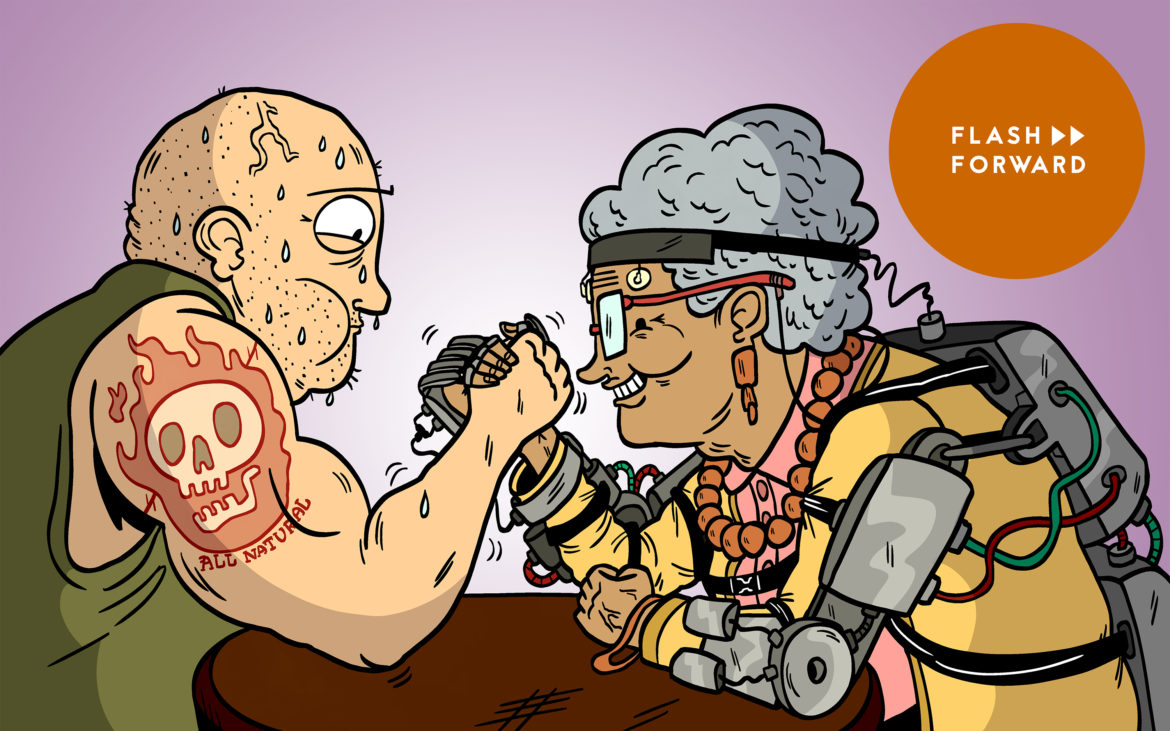
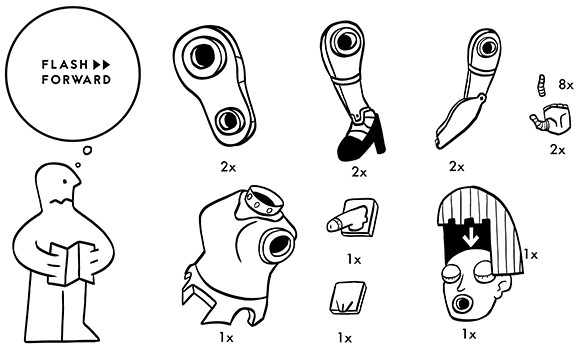
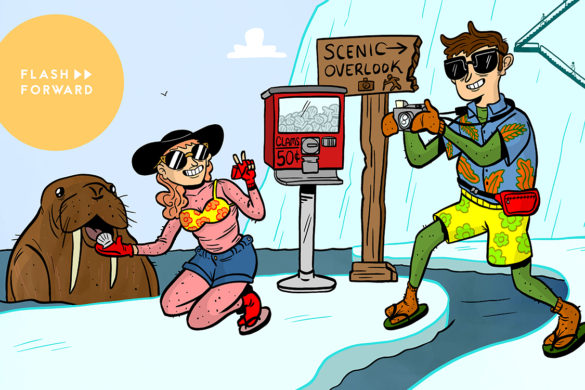
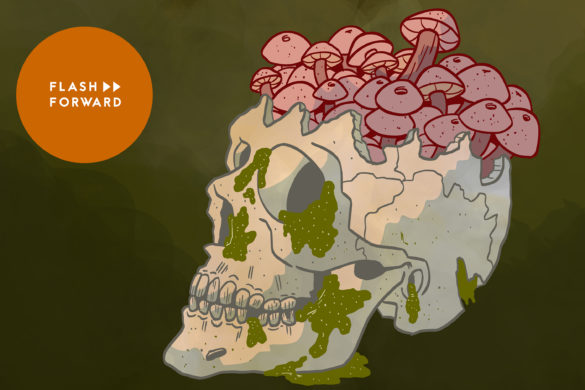

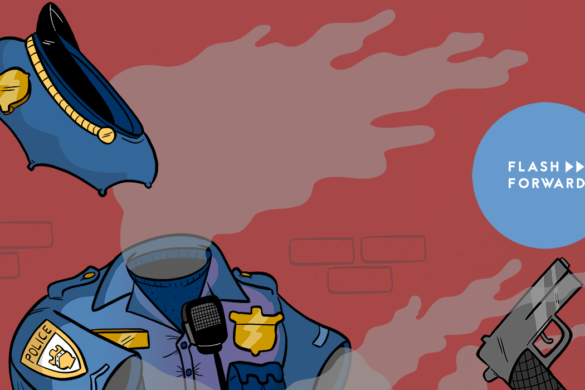
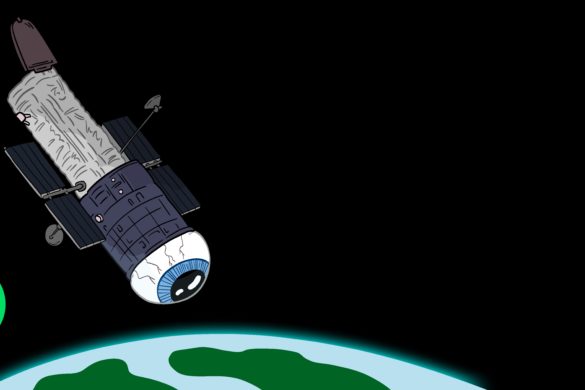

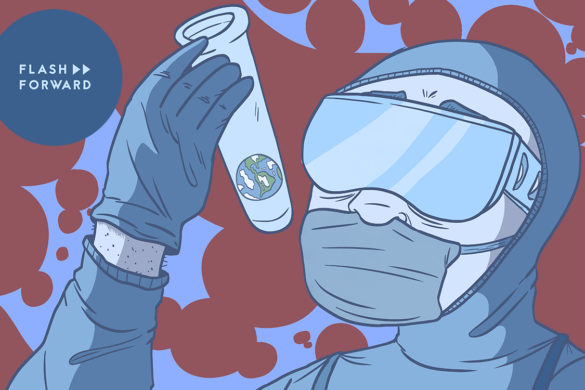
2 comments
Really good and important discussion of the terrible ways that exoskeletons (and the ability to walk) are sometimes framed in stories and the way this framing stigmatized people who use wheelchairs.
Test Comment!